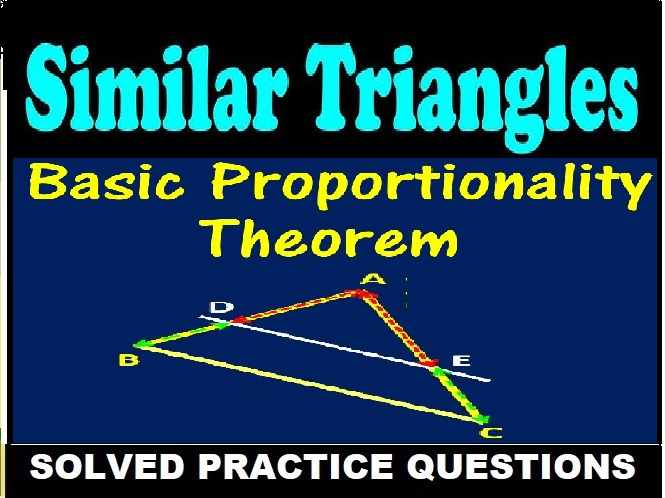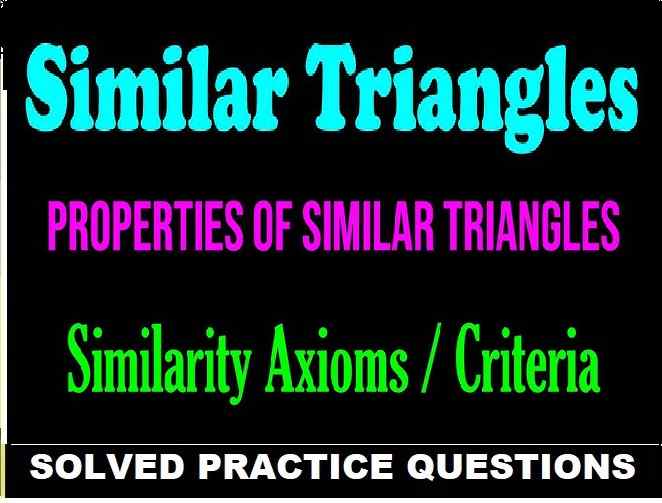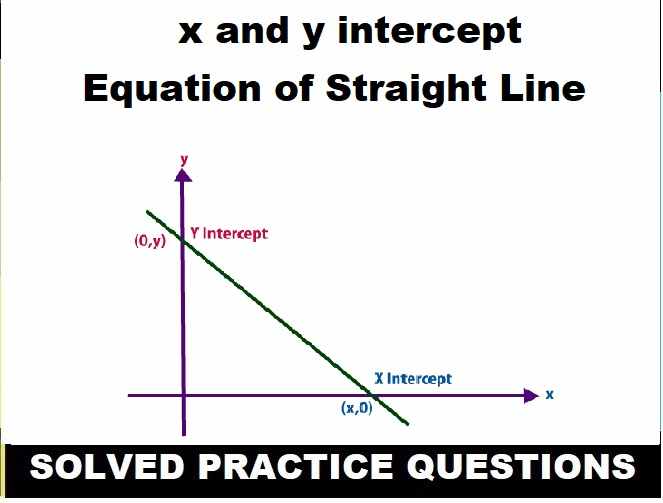Electricity Part-B Class-8th Concise Selina ICSE Physics Solutions Ch-8 . We Provide Step by Step Answer of Objective, True False , Fill in the blanks,Match the following Type and Short/ Long Answer of Exercise-8 Electricity . Visit official Website CISCE for detail information about ICSE Board Class-8.
Electricity Part-B Class-8th Concise Selina ICSE Physics Solutions Ch-8
-: Select Topic :-
Short/ Long Answer Question (B)
Part-A ( Obj, Short/Long, Numericals)
Electricity Part-B Class-8th Concise Selina ICSE Physics
Objective Questions
(Page 165)
1. Write true or false for each statement:
(e) When, glass rod is rubbed with dry silk cloth, the electrons move from glass to silk.
Answer : True
(f) The cap of gold leaf electroscope is made of copper.
Answer : False
(g) If a glass rod rubbed with silk is brought near the cap of a negatively charged electroscope, the divergence of leaves will decrease.
Answer : True
(h) In induction, a positively charged body can make an uncharged body positively charged.
Answer : False
(i) A lightning conductor saves the building from lightning.
Answer : True
(j) When a comb is rubbed with dry hair both comb and paper get similarly charged.
Answer : False
(k) A glass rod rubbed with silk repels an ebonite rod rubbed with fur.
Answer : False
(l) When an ebonite rod is rubbed with fur. The protons move from the ebonite rod to the fur.
Answer : False
(m) A conductor has a large number of free electrons.
Answer : True
(n) An ebonite rod can be charged by touching it with a charged copper rod.
Answer : False
(o) To find whether a body is charged or not, an uncharged electroscope is used.
Answer : True
(p) To find whether the charge on a body is positive or negative, an uncharged electroscope is used.
Answer : False
(q) If a negatively charged rod is brought near a negatively charged pith ball electroscope, the pith ball will be stuck with the rod.
Answer : False
2. Fill in the blanks :
(a) Like charges _repel _while unlike charges attract.
(b) Mercury is a _conductor_of electricity while pure water is _an insulator_ of electricity.
(c) An ebonite rod when rubbed with fur acquires the _negative _charge.
(d) When an uncharged conductor is brought in contact with the disc of a gold leaf electroscope, its leaved _ will remain unchanged__.
(e) Charge is shared in charging a conductor by the method of _conduction_.
3. Match the following:
| Column A | Column B |
|---|---|
| A. Two like charges | 1. Negative charge |
| B. Two unlike charges | 2. repel |
| C. Silver is a | 3. insulator |
| D. Silk is an | 4. attract |
| E. Ebonite rod rubbed with fur acquires | 5. conductor |
| Column A | Column B |
| A. Two like charges | 1 repel |
| B. Two unlike charges | 2 attract |
| C. Silver is a | 3 conductor |
| D. Silk is an | 4 insulator |
| E. Ebonite rod rubbed with fur acquires | 5 negative charge |
(a) When a glass rod is rubbed with dry silk cloth, the charge acquired by the silk cloth is
- Positive
- Negative
- Both positive and negative
- None of the above
Answer : 2. Negative
(b) When an ebonite rod is rubbed with fur, the rod acquires
- Positive charge
- Negative charge
- No charge
- None of the above
Answer : 2. Negative charge
(c) When a negatively charged body is brought closer to another negatively charged body, then they will show
- Attraction
- No effect
- Repulsion
- None of the above
Answer : 3. Repulsion
(d) Charging a conductor by bringing another charged conductor close to it without touching is called
- Induction
- Conduction
- Convection
- Radiation
Answer : 1. Induction
(e) The factor responsible for charging a conductor is
- Transfer of protons
- Transfer of neutrons
- Transfer of electrons
- Transfer of both protons and electrons
Answer : 3. Transfer of electrons
(f) Two objects when rubbed together get charged.The charges on them are
- Equal and opposite
- Equal and similar
- Unequal and similar
- Unequal and opposite
Answer : 1. Equal and opposite
(g) When a glass rod is rubbed with silk, the glass rod and the silk get charged because
- Electrons are transferred from the silk to the glass rod
- Electrons are transferred from the glass rod to the silk
- Protons are transferred from the silk to the glass rod
- Protons are transferred from the glass rod to the silk
Answer : 2. Electrons are transferred from the glass rod to the silk
(h) The conductor of electricity is
- Wood
- Glass
- Ebonite
- Human body
Answer : 4. Human body
(i) A gold leaf electroscope is to be charged positively by conduction. For this
- A positively charged rod is held close to near the disc of electroscope
- A positively charged rod is placed in contact with the disc of electroscope
- A negatively charged rod is held near the disc of electroscope
- A negatively charged rod is touched with the disc of electroscope
Answer : 2. A positively charged rod is placed in contact with the disc of electroscope
(j) A glass rod rubbed with silk is touched with the disc of a negatively charged gold leaf electroscope. The divergence of leaves will
- Decrease
- Increase
- Remain unchanged
- First decrease and then increase.
Answer : 1. Decrease
(k) The rod in a gold leaf electroscope is made up of
- Wood
- Brass
- Glass
- Ebonite
Answer : 2. Brass
(l) The lightning conductor is made up of:
- Copper
- Glass
- Ebonite
- Wood
Answer : 1. Copper
Short/ Long Answer Question
Chapter-8 Electricity Selina Physics for class-8 Part-B
(Page-166)
Question-1 :-
What do you understand by electricity at rest?
When the charges are not allowed to flow are termed as static electricity, i.e., the electricity at rest.
Question-2 :-
Why does a plastic comb rubbed with dry hair attract bits of paper?
Plastic comb rubbed with dry hair gets electrically charged and therefore it attracts the bits of paper.
Question-3 :- (Electricity Part-B Class-8th Concise )
Who discovered the way of producing electricity by friction?
The ancient Greek philosopher Thales of Miletus discovered the electricity by friction.
Question-4 :-
Name two substances which can be charged by friction.
Two substances which can be charged by friction are
- Glass.
- Ebonite.
Question-5 :-
What are the two kinds of charges?
The two kinds of charges are
- Negative charge
- Positive charge
Question-6 :-
A glass rod is rubbed with silk. State the kind of charge acquired by each.
A glass rod has free electrons which are less tightly bound, so when the rod is rubbed with silk it loses electrons to a silk piece. The glass rod has deficiency of electrons and acquires positive charge and the rod acquires negative charge.
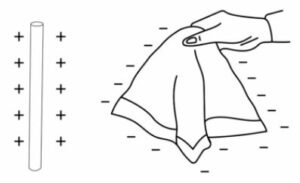
Question-7 :- (Electricity Part-B Class-8th Concise )
An ebonite rod is rubbed with fur. State the kind of charge acquired by each.
Answer-7 :-
When an ebonite rod is rubbed with fur, the fur loses electrons in the outermost shell because they are loosely bound compared to the rod. The ebonite rod has excess electrons now and it becomes negatively charged. The fur acquires a positive charge due to deficiency of electrons.
Question-8 :-
Describe and experiment to demonstrate that there are two kinds of charges.
Answer-8 :-
To show – There are two kinds of charges
Apparatus – (i) gold leaf electroscope (ii) glass rod (iii) silk piece (iv) any two non-identical bodies A and B
Experiment – Rub the glass rod with a silk piece, and then charge the gold leaf electroscope positively by touching it with glass rod.
The leaves of the gold leaf electroscope start diverging,and it shows its charge.
Now, touch the brass cap of the electroscope with body A and note the divergence of its leaves and similarly with body B.
Observation – In case of body A – leaves diverge and in case of body B – leaves converge
This says Body A is positively charged and Body B is negatively charged, showing two types of charges.
Question-9 :-
How will you show that like charges repel and unlike charges attract each other?
Answer-9 :-
To show – Like charges repel and unlike charges attract each other
Experiment – Take a glass rod rubbed with a silk piece that is positively charged. Suspend it in a stand with the help of a thread and bring a negatively charged ebonite rod rubbed with fur near the glass rod.
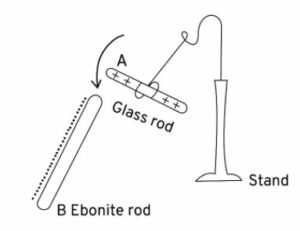
We see that two rods are attracted. Now suspend the ebonite rod and bring the glass rod near, we observe attraction between them again.

Observation – This shows that unlike charges attract each other.
Question-10 :-
A glass rod rubbed with silk is suspended near an ebonite rod rubbed with fur. What will be your observation? Give a reason to your answer.
Answer-10 :-
A glass rod rubbed with a silk piece that is positively charged and a negatively charged ebonite rod rubbed with fur is brought near the glass rod.
We see that two rods are attracted because they have opposite charges.
Question-11 :-
An ebonite rod rubbed with fur is suspended near another ebonite rod rubbed with fur. State your observation and give a reason to support your answer.
Answer-11 :-
Two ebonite rods rubbed with fur will have similar negative charges and like charges repel each other. Hence, the two rods will repel each other.
Question-12 :-
What do you mean by conservation of charges?
Answer-12 :-
Conservation of Charge is the principle that the total electric charge in a body never changes. The net quantity of electric charge, the amount of positive charge minus the amount of negative charge in the universe, is always conserved.
Question-13 :- (Electricity Part-B Class-8th Concise )
An ebonite rod is rubbed with fur. Compare the charges acquired by them.
Answer-13 :-
When an ebonite rod is rubbed with fur, the electrons are transferred from fur to ebonite rod. This results in excess electrons in the rod and makes it negatively charged and fur has a deficit of electrons of the same number and gets positively charged.
Question-14 :-
Name three constituents of an atom and state the kind of charge on each of them.
Answer-14 :-
The three constituents of an atom are:
(i) protons – positive charge
(ii) electrons – negative charge
(iii) neutrons – no charge
Question-15 :-
What is the net charge on an atom?
Answer-15 :-
The net charge on an atom is neutral that is zero.
Question-16 :-
Briefly describe the structure of an atom.
Answer-16 :-
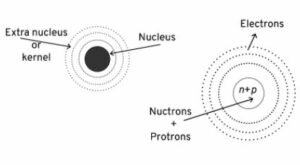
An atom has an equal number of protons (positive charge) and electrons (negative charge). It has neutrons which are present in the nucleus along with protons. Electrons keep revolving around the nucleus in shells.
Question-17 :-
What are free electrons?
Answer-17 :-
Electrons in the outermost shell of an atom, which can easily leave the atom and become free are called free electrons.
Question-18 :- (Electricity Part-B Class-8th Concise )
What causes the charging of two objects when they are rubbed together?
Answer-18 :-
When two objects are rubbed, there is transfer of electrons from one object to another. The body which has excess electrons is negatively charged and the body which has deficit electrons is positively charged.
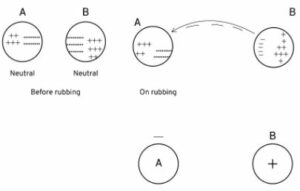
Question-19 :-
In each of the following cases, state which body loses electrons:
(a) A glass rod when rubbed with silk
(b) An ebonite rod when rubbed with fur.
Answer-19 :-
(a) Glass rod loses electrons
(b) Fur loses electrons
Question-20 :-
A glass rod is rubbed with silk. Explain the charging of the glass rod and the silk on the basis of electron movement.
Answer-20 :-
When a glass rod is rubbed with silk, glass rod loses electrons and silk gains electrons. Glass rod becomes positively charged and silk becomes negatively charged.
For example, suppose a glass rod has 10 protons and 10 electrons and silk has 7 electrons and 7 protons.
On rubbing together, the glass rod loses 2 electrons and silk gains 2 electrons. Now the glass rod has 8 electrons and 10 protons which makes it positively charged. Silk has 9 electrons and 7 protons making it negatively charged.
Question-21 :-
An ebonite rod is rubbed with fur. Explain the charging of the ebonite rod and the fur on the basis of electron movement.
Answer-21 :-
When an ebonite rod is rubbed with fur, fur loses electrons and ebonite rod gains electrons. fur becomes positively charged and rod becomes negatively charged.
For example, suppose an ebonite rod has 7 protons and 7 electrons and fur has 10 electrons and 10 protons.
On rubbing together,fur loses 2 electrons and the ebonite rod gains 2 electrons. Now fur has 8 electrons and 10 protons which makes it positively charged. The ebonite rod has 9 electrons and 7 protons making it negatively charged.
Question-22 :- (Electricity Part-B Class-8th Concise )
Distinguish between conductors and insulators of electricity.
Answer-22 :-
| Conductors | Insulators |
|---|---|
| They allow the current of electricity to flow through them. | They do not allow the current of electricity to flow through them. |
| They have large numbers of free electrons. | They have a small number of free electrons. |
| Metals like silver, copper, iron, gold and wet wood are conductors. | Cotton, dry wood, rubber, glass are insulators. |
| They cannot be charged by rubbing. | They can be charged by rubbing. |
Question-23 :-
Give one example each of a conductor and an insulator of electricity.
Answer-23 :-
Conductor – Hydrochloric acid
Insulator – Mica
Question-24 :-
State two ways of charging a conductor.
Answer-24 :-
The two ways of charging a conductor are:
(i) Conduction: The process of charging the uncharged object by bringing it in contact with another charged object is called charging by conduction.
(ii) Induction: The process of charging the uncharged object by bringing another charged object near to it, but not touching it, is called charging by induction.
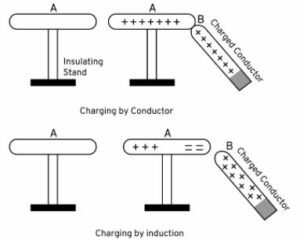
Question-25 :-
Name the way of charging a conductor in which the charge is shared.
Answer-25 :-
Conduction
Question-26 :-
Describe the method of charging a conductor by conduction.
Answer-26 :-
The process of charging the uncharged object by bringing it in contact with another charged object is called charging by conduction.
A charged object has an unequal number of negative (electrons) and positive charges (protons). Hence, when a charged object is brought in contact with the uncharged conductor, the electrons get transferred from the charged object to the conductor.
Consider an uncharged metal rod A kept on an insulating stand and a negatively charged conductor B as shown in below figure (1).
The process of charging the uncharged object by bringing it in contact with another charged object is called charging by conduction.

If we touch the uncharged conductor A with the negatively charged conductor B, transfer of electrons from charged conductor to uncharged conductor takes place. Hence, an uncharged conductor gains extra electrons and a charged conductor loses electrons. Thus, uncharged conductor A becomes negatively charged by gaining extra electrons.
Similarly, an uncharged conductor becomes positively charged if it is brought in contact with a positively charged conductor.
Question-27 :-
A metal rod A is to be charged positively by using another charged rod B. What should be the kind of charge on the rod B if charging is to be done by conduction?
Answer-27 :-
Since, rod A is uncharged and rod B is charged. Rod B should have a similar charge as required by Rod B. Rod A is to be charged positively, so rod B should be positively charged.
Question-28 :-
Explain the charging by conduction in terms of movement of electrons?
Answer-28 :-
Place rod A on an insulating stand and bring positively charged conductor Rod B near the rod A and touch it. The charge from rod B is transferred on Rod A till they both have a similar charge.
Suppose A has 10 protons and 10 electrons and B is positively charged is deficient in electrons having 20 electrons and 30 protons. On touching B with A, 5 protons are transferred to A
Now, A and B both have 5 protons in excess and have positive charge of 5 protons.
Question-29 :- (Electricity Part-B Class-8th Concise )
Describe the method of charging a conductor by induction.
Answer-29 :-
The process of charging the uncharged object by bringing another charged object near to it, but not touching it, is called charging by induction.
Consider an uncharged metal sphere and negatively charged plastic rod as shown in below figure (1). If we bring the negatively charged plastic rod near to the uncharged sphere as shown in below fig (2), charge separation occurs.
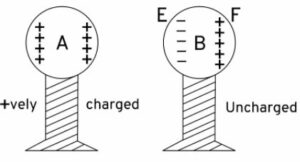
The process of charging the uncharged object by bringing another charged object near to it, but not touching it, is called charging by induction.
The positive charges in the sphere get attracted towards the plastic rod and move to one end of the sphere that is closer to the plastic rod. Similarly, negative charges get repelled from the plastic rod and move to another end of the sphere that is farther away from the plastic rod. Thus, the charges in the sphere rearrange themselves in a way that all the positive charges are nearer to the plastic rod and all the negative charges are farther away from it.
If this sphere is connected to a ground through the wire, free electrons of the sphere at the farther end flow to the ground. Thus, the sphere becomes positively charged by induction. If the plastic rod is removed, all the positive charges spread uniformly in the sphere.
Question-30 :-
Explain the charging by induction in terms of movement of electrons.
Answer-30 :-
Solution: Let uncharged conductor B mounted on insulated stand is placed near positively charged conductor A mounted on an insulated stand.

Electrons and protons are equal in uncharged conductor B, and the electrons of B are attracted towards protons of A making the end E of conductor B negatively charged called bound charge and protons remain at the end F of conductor B called free charge. There is an induced charge in B because conductor A is near B.
Question-31 :- (Electricity Part-B Class-8th Concise )
Figure below shows a metal rod AB placed on an insulating stand. In figure (a) a negatively charged ebonite rod C is touched with the metal rod AB, while in figure (b), the negatively charged ebonite rod C is held near the rod Ab. State the kind of charged at the ends A and B of the rod in each case.
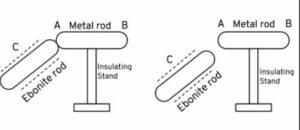
Answer-31 :-
In figure (a) conduction takes place, and there is negative charge at both ends A and B.
In figure (b) induction takes place, End A has oppositely positive charge and end B has negative charge
Question-32 :-
Can you charge an insulator by the method of conduction?
Answer-32 :-
No, we cannot charge an insulator by method of conduction.
Question-33 :-
What is an electroscope? Name the two types of electroscope.
Answer-33 :-
An electroscope is a device which helps us detect whether the body is charged or uncharged and detects the type of charge in the charged body, i.e. positive or negative charge.
The two types of electroscope are:
(i) pith ball electroscope
(ii) gold leaf electroscope

Question-34 :-
Describe a pith ball electroscope. How can you use it to test whether a body is charged or uncharged?
Answer-34 :-
A pith ball electroscope consists of a small pith ball suspended by a dry silk thread from an insulating stand.

To test the charge in a body, the body is brought near the pith ball without touching. If the pith ball moves towards the body, the body is charged and if the ball does not move, the body is uncharged.
Question-35 :-
How will you use a pith ball electroscope to find out whether the charge on a charged body is positive or negative?
Answer-35 :-
We take a positively charged pith ball electroscope, and the body is brought near the pith ball without touching. If the pith ball moves towards the body, the body has negative charge because unlike charges attract and if the ball moves away, the body has positive charges because like charges repel.
Question-36 :- (Electricity Part-B Class-8th Concise )
Draw a labelled diagram of a gold leaf electroscope and describe its construction.
Answer-36 :-
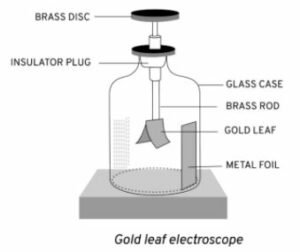
- It consists of a vertical metal rod, usually brass, from the end of which hang two parallel strips of thin flexible gold leaf.
- A disk or ball terminal is attached to the top of the rod, where the charge to be tested is applied.
- To protect the gold leaves from drafts of air they are enclosed in a glass bottle, usually open at the bottom and mounted over a conductive base.
- Often there are grounded metal plates or foil strips in the bottle flanking the gold leaves on either side.
- These are safety measures; if an excessive charge is applied to the delicate gold leaves, they will touch the grounding plates and discharge before tearing.
- They also capture charge leaking through the air that could accumulate on the glass walls, and increase the sensitivity of the instrument. In precision instruments the inside of the bottle was occasionally evacuated, to prevent the charge on the terminal from leaking off through ionization of the air.
Question-37 :-
A positively charged glass rod is touched with the disc of an uncharged gold leaf electroscope. What will be your observation?
Answer-37 :-
The leaves of the gold leaf electroscope diverge as they have positive charge due to conduction and like charges repel each other.
Question-38 :-
How will you use a gold leaf electroscope to find out whether a body is charged or uncharged?
Answer-38 :-
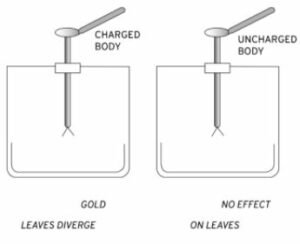
The body is brought near the disc of gold leaf electroscope, if the leaves diverge the body is charged and if the leaves converge, the body is uncharged.
Question-39 :- (Electricity Part-B Class-8th Concise )
How will you use a gold leaf electroscope to find out whether the charge on a charged body is positive or negative?
Answer-39 :-
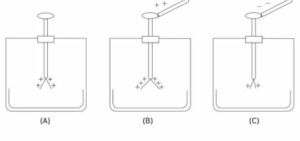
To detect the kind of charge on a body by a positively charged gold leaf electroscope, we use a negatively charged ebonite rod and touch it with the disc of the electroscope. The leaves will diverge because of repulsion, note the divergence in figure (a)
In figure (b) a charged body comes in contact with disc and divergence increases, that means it has a similar negative charge. In figure (c) the divergence decreases, that means it has an opposite positive charge.
Question-40 :-
A negatively charged ebonite rod is touched with the disc of a negatively charged gold leaf electroscope. What will be your observation?
Answer-40 :-
The divergence of leaves of gold leaf electroscope increases as similar charge increases.
Question-41 :-
When a charged rod is touched with the disc of a positively charged gold-leaf electroscope, it is observed that the divergence of leaves decreases. What is the kind of charge on the rod?
Answer-41 :-
The divergence of leaves of gold leaf electroscope decreases when opposite charge increases, that means the rod has a negative charge.
Question-42 :-
Describe Franklin’s experiment. What did he conclude from his experiment?
Answer-42 :-
Franklin’s experiment led to the invention of the lightning rod and the understanding of positive and negative charges. The connection between electricity and lightning was known but not fully understood. By conducting the kite experiment Franklin proved that lighting was an electrical discharge and realized that it can be charged over a conductor into the ground providing a safe alternative path and eliminating the risk of deadly fires.
Question-43 :-
What causes lightning?
Answer-43 :-
Lighter, positively charged particles form at the top of the cloud. Heavier, negatively charged particles sink to the bottom of the cloud. When the positive and negative charges grow large enough, a giant spark – lightning – occurs between the two charges within the cloud.
Question-44 :-
What are the effects of lightning?
Answer-44 :-
Lightning can cause widespread destruction of buildings and loss of lives of humans and animals.
Question-45 :-
What is a lightning conductor? How does it work?
Answer-45 :-
A lightning conductor is a device used to protect buildings from the damaging effect of the lightning. It runs from the top to the bottom of the building which is to be protected. If lightning strikes the building, the lightning conductor provides an easy and harmless path for the lightning bolt to pass through the ground without damaging the building.
The lightning conductor works on the principle of induction, such that when a charged cloud passes by the building, the conductor gets charge X opposite to that of the cloud through the process of induction. This acquired charge moves to the earth through the earthing system.

Question-46 :- (Electricity Part-B Class-8th Concise )
How is a tall building protected from damage due to lightning?
Answer-46 :-
By using lightning conductors, tall buildings can be protected from lightning. when a charged cloud passes by the building, the conductor gets charge X opposite to that of the cloud through the process of induction. The spikes are pointed and have a small area which cannot hold the charge and it leaks into air, such that the opposite charge in air and cloud is cancelled. This acquired charge moves to the earth through the earthing system.

Question-47 :-
State three safety measures that you will observe in thunderstorms.
Answer-47 :-
Safety measure in thunderstorms:
(i) Do not take baths during thunderstorms, and avoid contact with running water and metallic taps.
(ii) Do not lie on the ground, squat low on the ground with your hands on the knees and head in between.
(iii) Take out plugs of electrical appliances and do not charge the battery of mobile phones.
Return to- ICSE Class -8 Selina Concise Physics Solutions
Thanks
Please share with your friends .
